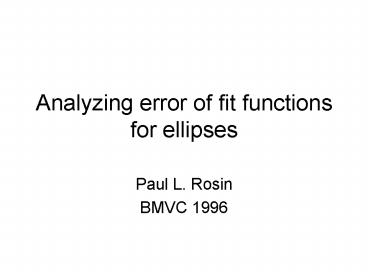Analyzing error of fit functions for ellipses - PowerPoint PPT Presentation
1 / 22
Title:
Analyzing error of fit functions for ellipses
Description:
Analyzing error of fit functions for ellipses Paul L. Rosin BMVC 1996 Why? Ellipse fitting to pupil boundary RANSAC (Random sample consensus) Explore fits Select best ... – PowerPoint PPT presentation
Number of Views:66
Avg rating:3.0/5.0
Title: Analyzing error of fit functions for ellipses
1
Analyzing error of fit functions for ellipses
- Paul L. Rosin
- BMVC 1996
2
Why?
- Ellipse fitting to pupil boundary
- RANSAC
- (Random sample consensus)
- Explore fits
- Select best fit
- Selection based on error criterion
3
Overview
- Ellipse Error of fit (EOF) functions
- How far is a point from ellipse boundary?
- Approx. to Euclidean dist (hard to compute!)
- Ellipse fitting using Least Squares (LS)
- Evaluation
- Linearity, Curvature bias, Asymmetry
X6
X5
e6
e5
e1
X1
X2
X4
e4
e2
e3
X3
4
Algebraic distance (AD)
- Simple to compute
- Closed form solution to LS ellipse exists
- High curvature bias (skewed ellipses)
- Super linear relationship with Euclidean dist
(sensitive to outliers)
Isovalue contours
5
Gradient weighted AD (GWAD)
Inversely weight AD with its gradient
Isovalue contours
- Reduced curvature bias
- Asymmetry exists
- Gradient inside gt gradient outside
6
Second order approximation
- Does not exist for points near high curvature
sections
Isovalue contours
7
Pavlidis approximation
- Improvement over basic algebraic distance
8
Reduced gradient weighted AD
- Compromise between AD (p 0) and GWAD (p 1)
- p is in the range (0, 1)
- Curvature bias lt AD
- Asymmetry lt GWAD
9
Directional derivative weighted AD
- Wavy isovalue contours of GWAD are reduced
C
Xj
r
EOF2
EOF10
10
Combined conic and circular dist
Circle
- Geometric mean of conic dist (AD) and circular
dist - Reduced curvature bias
- Asymmetry exists
Xc
Xj
Conic
Conic Circle
Isovalue contour
Xk
11
Concentric ellipse estimation
- Curvature bias significantly reduced
12
Concentric ellipse estimation
- Geometric mean of EOF1(AD) and EOF12a
- Low curvature bias
- Asymmetry exists
13
Focal bisector distance
- Reflection property PF is a reflection of PF
- Very low curvature bias
- Symmetric
14
Radial distance
- Comparison with focal bisector distance
T
EOF5 XjT
C
EOF13 XjIj
EOF5 XjT
15
Assessment
- Linearity
Pearsons correlation coefficient
Euclidean
EOF
? is in the range 0, 1, ideally ? 1
EOF2 ? 1
EOF1 ? lt 1
EOF
Euclidean
16
Assessment
- Linearity
- Points on farther isovalue contours contribute
more - Farther isovalue contours are longer
Mean euclidean distance along an isovalue contour
at Ei
Modified Pearsons correlation coefficient (more
uniform sampling)
Gaussian weighting according to distance d from
ellipse boundary
17
Assessment
- Curvature bias
Local variation of euclidean distance along an
isovalue contour at Ei
Global curvature measure considering all isovalue
contours Ei
Low values of C imply low curvature bias, ideally
C 0
18
Assessment
- Asymmetry
Mean of euclidean distance along an outside
isovalue contour at Ei
Mean of euclidean distance along an inside
isovalue contour at Ei
Local assymetry w.r.t. isovalue contour at Ei
Global assymetry measure considering all isovalue
contours Ei
Low values of A imply low asymmetry, ideally A 0
19
Assessment
- Combined measure
- Overall goodness
Weighted sum of square errors between euclidean
distance and scaled EOF
Global scaling factor S is determined by
optimizing G
20
Results
Normalized assessment measures w.r.t. EOF1
- EOF13 is the best!
- Except EOF2 and EOF10, all have reasonable
linearity - All have lower curvature bias than AD
- Except EOF13, all have poor asymmetry (EOF2 and
EOF10 are comparable)
21
Our work
- RANSAC consensus (selection)
- Algebraic dist vs. Focal bisector dist
Selection using algebraic distance
Selection using focal bisector distance
22
Thank you!!

